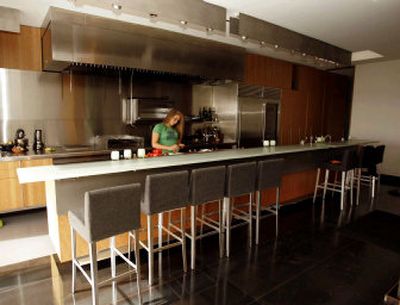House of steel and style

CARDIFF-BY-THE-SEA, Calif. – Near the crest of a hill overlooking the Pacific sits a small, sublime architectural adventure. Its boxy exterior, a windowless facade of steel and stucco, seems to recede into the landscape. But surprises start at the massive front door – an 8-by-9-foot stainless steel slab that opens electronically, like a bank vault.
Inside, floors of inky, blue-tinged steel, set like stone in 2-by-6-foot plates, meet walls of oiled hemlock. An entire ocean-facing wall of glass disappears when its panels fold up to the ceiling. And then there’s the master bedroom, which also functions as the master bath, its focal point a glow-in-the-night tub that is a hand-cast resin sculpture.
The house is profoundly personal, the shared minimalist vision of landscape architects Abbie and Bill Burton and their architect Jennifer Luce, who won two American Institute of Architects awards for it in May.
It’s the kind of house to experience, rather than just visit. The unusual blend of industrial and natural textures both soothes and startles. Luce manipulates light and space in ways that challenge convention and delight the senses.
“What we’re passionate about, along with Jennifer, is design from the essential elements. The raw character of the material is in full view, in its natural form, not covered by anything else,” Bill Burton says.
In Luce, 47, Canadian-born with a Harvard design degree, the couple found an artist who heeded the spirit, not just the specifics, of what they wanted.
The Burtons bought the 1970s, two-story house seven years ago. “It looked frightening at first,” Bill Burton says. “Really odd big bedrooms, black walls, mirrors everywhere.” But the couple agreed on the home’s potential. “It had a great ocean view, great basic form. The flat-roof shell was what we were attracted to. And we loved the upside-downness of it.”
Burton says the bedrooms were too big, the public spaces too small, the ocean view minimized by traditional doors and windows. The kitchen was awful for a couple who love to cook. “It was fit for a small apartment.”
The couple wanted the house totally closed in front, where it faces the street, and totally open to the view in back.
“Everybody’s private space would take a hit,” Burton says. “We would increase the public spaces, which is where we really live.”
It is now so different in every way from the original that AIA judges said they were “shocked that it was a remodel.”
The Burtons did keep a central skylight as a “kind of homage” to the old house. Luce turned that into what looks like an art installation by covering it at ceiling height with light-diffusing industrial fabric the same color as the ceiling.
And then there are those blue-tinged steel floors. The Burtons say they got the idea on a visit to a 50-year-old Wonder Bread bakery in San Diego, where they loved the look of the steel floor, including the marbled patina that occurs over time (which some might call rust).
“We love the blue, so now we’re going about the process of finding ways to protect and keep the color the way it is,” Burton says.
Luce commissioned the steel plates from one of many different metal craftspeople with whom she regularly works. The result is a floor that almost calls out to be touched. Slip off a sandal on a torrid day, and steel caresses the sole with its cool, soft, satiny surface. (Yes, we know steel is hard. But it doesn’t feel that way.)
Steel is used in many ways throughout the house. Entering, what you first see is the profile of a sculptural black steel staircase with what appears to be a vast solid wall of hemlock behind it. The wall isn’t solid at all. It contains invisible doors that camouflage entries to closets, a powder room and the two teenagers’ rooms on the other side of the wall, which each have a bath and garden view.
The stairway leads up to the heart of the house –- the commercially rated kitchen. It forms the center of what is essentially one large open living, dining and cooking area, all with an ocean view. Because the Burtons are avid cooks, Luce says, they wanted the kitchen as part of the main living space.
Burton calls the kitchen “ground zero of the house. We live around it, because that’s how we … like to live. We cook, we talk, that’s what we do.”
Of course, by making the home’s social spaces larger, it “caused the second-floor master bedroom to become smaller and more challenging,” Luce says, “which is how the bedroom and bathroom came to merge.”
It is an uncluttered space, 15 by 20, in which the Burtons sleep, bathe and shower – with no physical separation for any of those functions. The tub, a hand-cast resin sculpture that glows gently at night, dominates the room, along with an abstract canvas by William DeBilzan that sits above it.
Then there’s that horizontal steel trough set low into the living room wall, filled with what look like crystals. It appears to be a decorative touch. But there are no decorative touches in this minimalist environment. Every form must have its function. Burton clicks a lighter and flame shoots up through the bits of recycled glass: It is the fireplace.